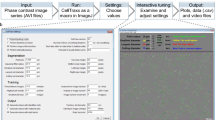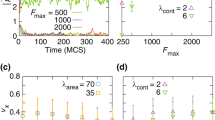Abstract
Cell migration through 3D extracellular matrices (ECMs) is crucial to the normal development of tissues and organs and in disease processes, yet adequate analytical tools to characterize 3D migration are lacking. The motility of eukaryotic cells on 2D substrates in the absence of gradients has long been described using persistent random walks (PRWs). Recent work shows that 3D migration is anisotropic and features an exponential mean cell velocity distribution, rendering the PRW model invalid. Here we present a protocol for the analysis of 3D cell motility using the anisotropic PRW model. The software, which is implemented in MATLAB, enables statistical profiling of experimentally observed 2D and 3D cell trajectories, and it extracts the persistence and speed of cells along primary and nonprimary directions and an anisotropic index of migration. Basic computer skills and experience with MATLAB software are recommended for successful use of the protocol. This protocol is highly automated and fast, taking <30 min to analyze trajectory data per biological condition.
This is a preview of subscription content, access via your institution
Access options
Subscribe to this journal
Receive 12 print issues and online access
$259.00 per year
only $21.58 per issue
Buy this article
- Purchase on Springer Link
- Instant access to full article PDF
Prices may be subject to local taxes which are calculated during checkout




Similar content being viewed by others
References
Pollard, T.D. & Borisy, G.G. Cellular motility driven by assembly and disassembly of actin filaments. Cell 112, 453–465 (2003).
Lauffenburger, D.A. & Horwitz, A.F. Cell migration: a physically integrated molecular process. Cell 84, 359–369 (1996).
Ridley, A.J. et al. Cell migration: Integrating signals from front to back. Science 302, 1704–1709 (2003).
Jin, H. & Varner, J. Integrins: roles in cancer development and as treatment targets. Br. J. Cancer 90, 561–565 (2004).
Wirtz, D., Konstantopoulos, K. & Searson, P.C. The physics of cancer: the role of physical interactions and mechanical forces in metastasis. Nat. Rev. Cancer 11, 512–522 (2011).
Luster, A.D., Alon, R. & von Andrian, U.H. Immune cell migration in inflammation: present and future therapeutic targets. Nat. Immunol. 6, 1182–1190 (2005).
Martin, P. Wound healing: aiming for perfect skin regeneration. Science 276, 75–81 (1997).
Tranquillo, R.T., Lauffenburger, D.A. & Zigmond, S.H. A stochastic model for leukocyte random motility and chemotaxis based on receptor-binding fluctuations. J. Cell Biol. 106, 303–309 (1988).
Tranquillo, R.T. & Lauffenburger, D.A. Stochastic model of leukocyte chemosensory movement. J. Math. Biol. 25, 229–262 (1987).
Stokes, C.L., Lauffenburger, D.A. & Williams, S.K. Migration of individual microvessel endothelial cells: stochastic model and parameter measurement. J. Cell Sci. 99, 419–430 (1991).
Stokes, C.L. & Lauffenburger, D.A. Analysis of the roles of microvessel endothelial cell random motility and chemotaxis in angiogenesis. J. Theor. Biol. 152, 377–403 (1991).
Parkhurst, M.R. & Saltzman, W.M. Quantification of human neutrophil motility in 3-dimensional collagen gels: effect of collagen concentration. Biophys. J. 61, 306–315 (1992).
Berg, H.C. Random Walks in Biology (Princeton University Press, 1993).
Czirok, A., Schlett, K., Madarasz, E. & Vicsek, T. Exponential distribution of locomotion activity in cell cultures. Phys. Rev. Lett. 81, 3038–3041 (1998).
Takagi, H., Sato, M.J., Yanagida, T. & Ueda, M. Functional analysis of spontaneous cell movement under different physiological conditions. PLoS ONE 3 e2648 (2008).
Selmeczi, D., Mosler, S., Hagedorn, P.H., Larsen, N.B. & Flyvbjerg, H. Cell motility as persistent random motion: theories from experiments. Biophys J. 89, 912–931 (2005).
Fraley, S.I. et al. A distinctive role for focal adhesion proteins in three-dimensional cell motility. Nat. Cell Biol. 12, 598–604 (2010).
Fraley, S.I., Feng, Y., Giri, A., Longmore, G.D. & Wirtz, D. Dimensional and temporal controls of three-dimensional cell migration by zyxin and binding partners. Nat. Commun. 3, 719 (2012).
Giri, A. et al. The Arp2/3 complex mediates multigeneration dendritic protrusions for efficient 3-dimensional cancer cell migration. FASEB J. 27, 4089–4099 (2013).
Tang, H. et al. Loss of Scar/WAVE complex promotes N-WASP- and FAK-dependent invasion. Curr. Biol. 23, 107–117 (2013).
Yu, X. & Machesky, L.M. Cells assemble invadopodia-like structures and invade into Matrigel in a matrix metalloprotease dependent manner in the circular invasion assay. PLoS ONE 7, e30605 (2012).
Zaman, M.H. et al. Migration of tumor cells in 3D matrices is governed by matrix stiffness along with cell-matrix adhesion and proteolysis. Proc. Natl. Acad. Sci. USA 103, 10889–10894 (2006).
Khatau, S.B. et al. The distinct roles of the nucleus and nucleus-cytoskeleton connections in three-dimensional cell migration. Sci. Rep. 2, 488 (2012).
Gilkes, D.M. et al. Hypoxia-inducible factors mediate coordinated RhoA-ROCK1 expression and signaling in breast cancer cells. Proc. Natl. Acad. Sci. USA 111, E384–393 (2014).
Kim, D.H. & Wirtz, D. Focal adhesion size uniquely predicts cell migration. FASEB J. 27, 1351–1361 (2013).
Friedl, P., Sahai, E., Weiss, S. & Yamada, K.M. New dimensions in cell migration. Nat. Rev. Mol. Cell Biol. 13, 743–747 (2012).
Wu, P.H., Giri, A., Sun, S.X. & Wirtz, D. Three-dimensional cell migration does not follow a random walk. Proc. Natl. Acad. Sci. USA 111, 3949–3954 (2014).
Hung, W.C. et al. Distinct signaling mechanisms regulate migration in unconfined versus confined spaces. J. Cell Biol. 202, 807–824 (2013).
Stroka, K.M. et al. Water permeation drives tumor cell migration in confined microenvironments. Cell 157, 611–623 (2014).
Ehrbar, M. et al. Elucidating the role of matrix stiffness in 3D cell migration and remodeling. Biophys. J. 100, 284–293 (2011).
Kutys, M.L. & Yamada, K.M. An extracellular-matrix-specific GEE GAP interaction regulates Rho GTPase crosstalk for 3D collagen migration. Nat. Cell Biol. 16, 909–917 (2014).
Pankov, R. et al. A Rac switch regulates random versus directionally persistent cell migration. J. Cell Biol. 170, 793–802 (2005).
Wolf, K. et al. Compensation mechanism in tumor cell migration: mesenchymal-amoeboid transition after blocking of pericellular proteolysis. J. Cell Biol. 160, 267–277 (2003).
Wu, P.H., Arce, S.H., Burney, P.R. & Tseng, Y. A novel approach to high accuracy of video-based microrheology. Biophys. J. 96, 5103–5111 (2009).
Wu, P.H. et al. High-throughput ballistic injection nanorheology to measure cell mechanics. Nat. Protoc. 7, 155–170 (2012).
Acknowledgements
This work was supported in part by the US National Institutes of Health grant U54CA143868.
Author information
Authors and Affiliations
Contributions
A.G. conducted the experiments; P.-H.W. developed, tested, applied and validated the APRW model; and A.G., P.-H.W. and D.W. designed the experiments, analyzed the results and wrote the paper.
Corresponding authors
Ethics declarations
Competing interests
The authors declare no competing financial interests.
Supplementary information
Supplementary Text and Figures
Supplementary Methods (PDF 188 kb)
Supplementary Software
Contains MATLAB scripts. (ZIP 21 kb)
Supplementary Data
Contains example excel sheets (ZIP 3455 kb)
Rights and permissions
About this article
Cite this article
Wu, PH., Giri, A. & Wirtz, D. Statistical analysis of cell migration in 3D using the anisotropic persistent random walk model. Nat Protoc 10, 517–527 (2015). https://doi.org/10.1038/nprot.2015.030
Published:
Issue Date:
DOI: https://doi.org/10.1038/nprot.2015.030
This article is cited by
-
Microinterfaces in biopolymer-based bicontinuous hydrogels guide rapid 3D cell migration
Nature Communications (2024)
-
Morphomigrational description as a new approach connecting cell's migration with its morphology
Scientific Reports (2023)
-
Efficient deformation mechanisms enable invasive cancer cells to migrate faster in 3D collagen networks
Scientific Reports (2022)
-
Hemocytes in Drosophila melanogaster embryos move via heterogeneous anomalous diffusion
Communications Physics (2022)
-
Force-FAK signaling coupling at individual focal adhesions coordinates mechanosensing and microtissue repair
Nature Communications (2021)
Comments
By submitting a comment you agree to abide by our Terms and Community Guidelines. If you find something abusive or that does not comply with our terms or guidelines please flag it as inappropriate.



